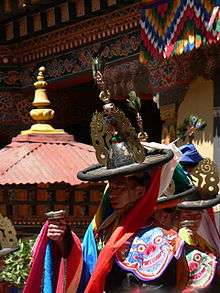Paro Taktsang
Paro Taktsang (Dzongkha: སྤ་གྲོ་སྟག་ཚང་, also known as the Taktsang Palphug Monastery and the Tiger's Nest),[1] is a prominent Himalayan Buddhist sacred site and the temple complex is located in the cliffside of the upper Paro valley in Bhutan.
| Paro Taktsang | |
|---|---|
 View of Paro Taktsang | |
| Religion | |
| Affiliation | Tibetan Buddhism |
| Sect | Drukpa Kagyu and Nyingma |
| Deity | Guru Padmasambhava |
| Location | |
| Location | Paro Valley, Paro District, Bhutan |
| Country | Bhutan |
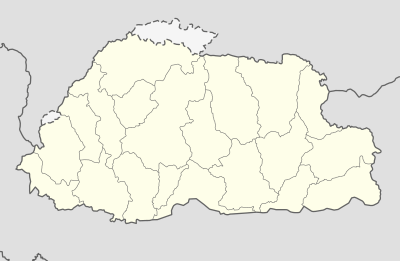 Location within Bhutan | |
| Geographic coordinates | 27°29′30.88″N 89°21′48.56″E |
| Architecture | |
| Style | Bhutanese |
| Date established | 8th century (as a meditation cave) 1692 (formally built as a monastery) |
A temple complex was first built in 1692, around the Taktsang Senge Samdup cave where Guru Padmasambhava is said to have meditated for Four Months in the 8th century.[2] Padmasambhava is credited with introducing Buddhism to Bhutan and is the tutelary deity of the country.[3] Today, Paro Taktsang is the best known of the thirteen taktsang or "tiger lair" caves in which he meditated.
The temple devoted to Padmasambhava (also known as Gu-ru mTshan-brgyad Lhakhang, "the Temple of the Guru with Eight Names") is an elegant structure built around the cave in 1692 by Gyalse Tenzin Rabgye. It has become the cultural icon of Bhutan.[4][5][6] A popular festival, known as the Tsechu, held in honor of Padmasambhava, is celebrated in the Paro valley sometime during March or April.[7]
History
Background and legends
According to the Namthar of the Lhakhang (related to this Taktsang (which in Tibetan language is spelled stag tshang), which literally means "Tigress lair", it is believed that Padmasambhava (Guru Rinpoche) flew to this location from Singye Dzong on the back of a tigress.[8] This place was consecrated to tame the Tiger demon.
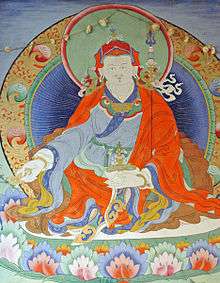
An alternative legend holds that a former wife of an emperor, known as Yeshe Tsogyal, willingly became a disciple of Guru Rinpoche (Padmasambahva) in Tibet. She transformed herself into a tigress and carried the Guru on her back from Tibet to the present location of the Taktsang in Bhutan. In one of the caves here, the Guru then performed meditation and emerged in eight incarnated forms (manifestations) and the place became holy. Subsequently, the place came to be known as the “Tiger's Nest”.[8]
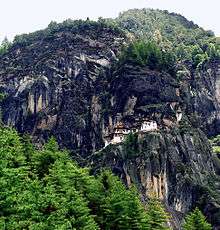
The popular legend of the Taktsang monastery is further embellished with the story of Tenzin Rabgye, who built the temple here in 1692. It has been mentioned by authors that the 8th century guru Padmasmabhava had reincarnated again in the form of Tenzin Rabgye. The corroborative proofs mooted are: that Tenzin Rabgye was seen (by his friends) concurrently inside and outside his cave; even a small quantity of food was adequate to feed all visitors; no one was injured during worship (in spite of the approach track to the monastery being dangerous and slippery); and the people of the Paro valley saw in the sky various animal forms and religious symbols including a shower of flowers that appeared and also vanished in the air without touching the earth.[4]
Establishment as a meditation site
As noted before, the monastery was built around the Taktsang Senge Samdup (stag tshang seng ge bsam grub) cave, where custom holds that the Indian Guru Padmasambhava meditated in the 8th century. He flew to this place from Tibet on the back of Yeshe Tsogyal, whom he transformed into a flying tigress for the purpose and landed at the cliff, which he "anointed" as the place for building a monastery. He established Buddhism and the Nyingmapa school of Mahayana Buddhism in Bhutan, and has been considered the “protector saint of Bhutan”. Later, Padmasmbahva visited Bumthang district to subdue a powerful deity offended by a local king. Padmasambhava's body imprint is stated to be imprinted on the wall of a cave near Kurje Lhakhang temple. In 853, Langchen Pelkyi Singye came to the cave to meditate and gave his name of Pelphug to the cave, "Pelkyi's cave".[8] After he died later in Nepal, his body was said to have been miraculously returned to the monastery by the grace of the deity Dorje Legpa; it is now said to be sealed in a chorten in a room to the left at the top of the entrance stairway.[8] The chorten was restored in 1982-83 and again in 2004.[8]
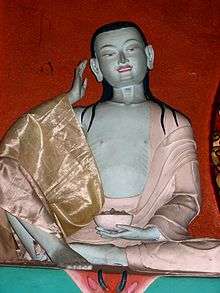
From the 11th century, many Tibetan saints and eminent figures came to Taktsang to meditate, including Milarepa (1040–1123), Pha Dampa Sangye (died 1117), the Tibetan yogini Machig Labdrön (1055–1145) and Thangton Gyelpo (1385–1464).[8] In the latter part of the 12th century, the Lapa School was established in Paro.[9] Between 12th and 17th centuries, many Lamas who came from Tibet established their monasteries in Bhutan. The first sanctuary to be built in the area dates to the 14th century when Sonam Gyeltshen, a Nyingmapa lama of the Kathogpa branch came from Tibet.[8] The paintings he brought can still be faintly discerned on a rock above the principal building although there is no trace of the original one.[8] The Taktsang Ugyen Tsemo complex, which was rebuilt after a fire in 1958 is said to date back to 1408.[8] Taktsang remained under the authority of the Kathogpa lamas for centuries until the mid 17th century.[8]
17th century to present: The modern monastery
In the 17th century the well-known Tertön Pema Lingpa of Bumthang, who founded many monasteries in various parts of Bhutan, was also instrumental in creating religious and secular dance forms from his conception of the 'Zandog Pelri' (the Copper Colored mountain), which was the abode of the Guru Padmasambahva (which is the same place as the Paro Taktsang or Tiger's nest). This dance is performed in Paro as the Tsche festival. But it was during the time of Ngawang Namgyal of the Drukpa subsect, who fled Tibet to escape persecution by the opposing sect of the Gelugpa order (which dominated Tibet under the Dalai Lamas), that an administrative mechanism was established in Bhutan.
In due time, he established himself in Bhutan as a 'model of rulership' and was known as the "Shabdrung" with full authority. He wanted to establish an edifice at the Taktsang Pel Phuk site. It was during a Tibetan invasion of Bhutan in 1644-46 that Shabdrung and his Tibetan Nyingmapa teacher gTer-ston Rig-’dzin sNying-po had invoked Padmasambhava and the protective deities at Taktsang to give them success over the invaders. He performed the bka’ brgyad dgongs ’dus rituals associated with the celebrations of Tshechu. Bhutan won the war against Tibet However, Shabdrung was not able to build a temple at Takstsang to celebrate the event, even though he very much wanted to do so.[4][9][10][11]
The wish of Shabdrung to build a temple here, however, was fulfilled during the 4th Druk Desi Tenzin Rabgye (1638–96), the first, and only successor of Shabdrung Ngawang Namgyel (Zhabs-drung Ngag-dbang rNam-rgyal), "a distant cousin from a collateral line descending from the 15th century ‘crazy saint’ Drukpa Kunley". During his visit to the sacred cave of Taktsang Pel Phuk during the Tshechu season of 1692 he laid the foundation for building the temple dedicated to Guru Rinpoche called the ‘Temple of the Guru with Eight Names’ (’gu ru mtshan brgyad lha-khang). It was a decision taken by Tenzin Rabgye while standing at the cave overlooking the Paro valley. At this time, he was leading the Tshechu festival of religious dances.[4] At that time the only temples reported to be in existence, at higher elevations, were the Zangdo Pelri (Zongs mdog dPalri) and Ugyen Tsemo (Urgyan rTse-mo).[4]
Fire destruction
On April 19, 1998,[12] a fire broke out in the main building of the monastery complex, which contained valuable paintings, artifacts and statues. The fire is believed to have been caused by electrical short-circuiting or flickering butter lamps lighting the hanging tapestries. A monk also died during the fire. The restoration works were undertaken at an estimated cost of 135 million ngultrum. The Government of Bhutan and the then King of Bhutan, Jigme Singye Wangchuck, oversaw the restoration of the damaged monastery and its contents in 2005.[13][14][15]
Geography
_Monastery%2C_Paro_Valley.jpg)
The monastery is located 10 kilometres (6.2 mi) to the north of Paro and hangs on a precarious cliff at 3,120 metres (10,240 ft), about 900 metres (3,000 ft) above the Paro valley, on the right side of the Paro Chu (‘chu’ Bhutanese means ”river or water”. The rock slopes are very steep (almost vertical) and the monastery buildings are built into the rock face. Though it looks formidable, the monastery complex has access from several directions, such as the northwest path through the forest, from the south along the path used by devotees, and from the north (access over the rocky plateau, which is called the “Hundred Thousand Fairies” known as Bumda (hBum-brag). A mule track leading to it passes through pine forest that is colorfully festooned with moss and prayer flags. On many days, clouds shroud the monastery and give an eerie feeling of remoteness.[16][17]

Near the beginning of the trail is a water-powered prayer wheel, set in motion by a flowing stream. The water that is touched by the wheel is said to become blessed and carries its purifying power into all life forms in the oceans and lakes that it feeds into.[18] On the approach path to the monastery, there is a Lakhang (village level monastery) and a temple of Urgyan Tsemo ("U-rgyan rTse-mo") which, like the main monastery, is located on a rocky plateau with a precipitous projection of several hundred feet over the valley. From this location, the monastery’s buildings are on the opposite ravine, which is known by the name “Copper-Colored Mountain Paradise of Padmasambhava”. This is the view point for visitors and there is a cafeteria to provide refreshments.[19] The trek beyond this point is very scenic with the sound of the water fall breaking the silence.[20] Along the trek route blue pine trees, prayer flags and kiosks selling paraphernalia for worship (such as prayer wheels, temple bells and skulls) are seen. The route is scattered with number of temples. On this path, a large water fall, which drops by 60 metres (200 ft) into a sacred pool, is forded over by a bridge. The track terminates at the main monastery where colorful paintings are displayed. Guru Rinpoche's cave where he meditated is also seen. This cave is opened for public viewing only once a year.[21]
Structure
Exterior
-Kloster_in_Bhutan_2.jpg)
The monastery buildings consist of four main temples and residential shelters ideally designed by adapting to the rock (granite) ledges, the caves and the rocky terrain. Out of the eight caves, four are comparatively easy to access. The cave where Padmasmabhava first entered, riding the Tiger, is known as 'Tholu Phuk' and the original cave where he resided and did meditation is known as the 'Pel Phuk'. He directed the spiritually enlightened monks to build the monastery here. The monastery is so precariously perched that it is said: "it clings to the side of the mountain like a gecko". The main cave is entered through a narrow passage. The dark cave houses a dozen images of Bodhisattvas and butter lamps flicker in front of these idols. An elegant image of Chenrezig (Avalokitesvara) is also deified here. In an adjoining small cell, the sacred scripture is placed; the importance of this scripture is that it has been scripted with gold dust and the crushed bone powder of a divine Lama. It is also said that the monks who practice Vajrayana Buddhism (the formal State Religion of Bhutan) at this cave monastery live here for three years and seldom go down to the Paro valley.[6][22][23]
All the buildings are interconnected through steps and stairways made in rocks. There are a few rickety wooden bridges along the paths and stairways also to cross over. The temple at the highest level has a frieze of Buddha. Each building has a balcony, which provides lovely views of the scenic Paro valley down below. The Monasteries have ancient history of occupation by monks, as hermitages.[6][22]
Other structures within the precincts

Taktshang Zangdo Pari is the place where Padmasmbahava’s wife, known as the “Fairy of Wisdom”, Yeshe Tshogyal (Ye-shes mtsho-rgyal), the founder of the Mon, a convent, by the same name as Taktshang and also two other convents. The present caretaker of the place is said to be an old nun supported by a young trainee.
Another important place near the shrine is the Urgyan Tsemo, the “Peak of Urgyan” which has a small Mani Lakhang. The prayer wheel, turned by an old monk, resounds with chimes that are heard every day at 4 am. Above the Urgyan is the holy cave temple known as 'Phaphug Lakhang' (dPal-phug IHa-khang), which is the main shrine of the Taktshang. It is also the residence of the Head Lama, Karma Thupden Chokyi Nyenci.
Paintings

The “Copper-Coloured Mountain Paradise of Padmasambahva” (Zangdopari) is vividly displayed in a heart shape on every thangkha and also painted on the walls of the monastery as a constant reminder of the legend. The paintings are set on a pedestal that represents the realm of the King of Nagas amidst Dakinis (mKha-hgro-ma), and the pinnacle in the painting denotes the domain of Brahma. The paintings also depict Klu (Naga) demigods with a human head and the body of a serpent, which are said to reside in lakes (said to denote that they are guarding the hidden treasures). Allegorically, they mean to represent the spiritual holy writings. The paintings also show what is termed as “Walkers in the Sky” (mKha-hgro-ma).
The holy hill is drawn in the backdrop with four faces painted with different colors – the east face is in crystal white color, the south face is yellow, the west is in red color and the north has green color. The palace has four sides and eight corners with its lower and upper tiers adorned with jewels. The courtyard with four enclosures is said to represent four kinds of conduct. The walls are built with bricks, balconies have been bejewelled with religious symbols. The ambience is shown in the form of wishing trees, fountains of the water of life, rain bows in five colors with cloud formations and light emanating from lotus flowers. The palace is also shown with a throne with eight corners fully and curiously bejewelled. Padmasmbahva is shown sitting on a pure stalk of lotus emitting divine energy appearing “divine, charitable, powerful, or fierce”.
Further detailing depicted on the four faces and eight corners, are five kinds of Buddhas suppressing the vicious demons (performing four pious deeds) and placed on thrones that are mounted over the stooping demons. The demons and Khadoms are depicted adorned and seated on four petalled and four faced thrones “adorned with necromantic attributes” enjoying a good time; the Khadoms are seen on the four-sided courtyard of the palace and also on all side walls.
The scene is further embellished around the Guru Rinpoche (Padmashambahava) image and also in the palace, with gods and goddesses in the heavens, with gate keepers at the four gates with an army of messengers and servants; all trying to crush the demons to dust. The supporting staff shown are said to represent the Himalayan tribes of pre-Buddhist periods.
References
- Lopen Kunzang Tinley (2008). Seeds of Faith: A Comprehensive Guide to the Sacred Places of Bhutan. V1. Thimphu: KMT Publishers. pp. 121–130. ISBN 99936-22-42-7.
- "The Ultimate Guide to Hiking to the Tiger's Nest, Bhutan".
- "Padmasambhava the Precious Guru of Tibetan Buddhism".
- Ardussi, John A. (1999). "Gyalse Tenzin Rabgye and the Founding of Taktsang Lhakhang" (pdf). Journal of Bhutan Studies. Thimphu: Centre for Bhutan Studies. 1 (1): 28. Retrieved 2010-03-12.
- Williamson, Teresa Rodriguez (2007). Fly Solo: The 50 Best Places on Earth for a Girl to Travel Alone. Perigee. p. 170. ISBN 0-399-53310-9. Retrieved 2010-03-12.
- Yowell, Skip (2007). The Hippie Guide to Climbing the Corporate Ladder and Other Mountains: How ... Thomas Nelson. pp. 155–156. ISBN 1-59555-852-7. Retrieved 2010-03-12.
- "Things to Know about Tshechu Festival in Bhutan".
- Pommaret, Francoise (2006). Bhutan Himalayan Mountains Kingdom (5th edition). Odyssey Books and Guides. pp. 136–7.
- Shaw, Brian (2003). The Far East and Australasia, 2003. Bhutan: Early History. Routledge. pp. 180–181. ISBN 1-85743-133-2. Retrieved 2010-03-12.
- "The Paro Tsechu". Retrieved 2010-03-07.
- "The Paro Tsechu – the Thondrol of Guru Rincpoche". Retrieved 2010-03-07.
- Crossette, Barbara (1998-04-22). "Fire Destroys Famed Monastery in the Himalayas". The New York Times. ISSN 0362-4331. Retrieved 2020-06-11.
- Brown, Lindsay; Bradley Mayhew, Stan Armington; Richard Whitecross (2007). Bhutan. Lonely Planet. pp. 129–130. ISBN 1-74059-529-7. Retrieved 2010-04-19.
- Harrison, Peter (2004). Castles of God: fortified religious buildings of the world. Boydell Press. pp. 268–270. ISBN 1-84383-066-3. Retrieved 2010-03-12.
- Monteath, Colin (2006). Climb Every Mountain: A Journey to the Earth's Most Spectacular High Altitude Locations. Frances Lincoln ltd. pp. 118–119. ISBN 0-7112-2674-1. Retrieved 2010-03-12.
- "Druk Path Trek". Retrieved 2010-03-07.
- "In The Kingdom Of Bhutan". Global Sapiens. October 6, 2002. Retrieved 2010-03-07.
- lywa (2015-04-02). "The Benefits of Prayer Wheels". www.lamayeshe.com. Retrieved 2017-03-08.
- "Bhutan Journey". Day 12: Paro-Taktsang (Tiger's Nest ). India Paradise Explored. Archived from the original on 2009-06-15. Retrieved 2010-04-19.
- Schultz, Patricia (2003). 1,000 places to see before you die. Workman Publishing. p. 441. ISBN 0-7611-0484-4. Retrieved 2010-04-19.
Taktsang, the Tiger’s nest is a destination of treks long and short…It is startlingly scenic, with nothing breaking the silence except a water fall…
- Sacred Places of a Lifetime: 500 of the World's Most Peaceful and Powerful ... Taktsang. National Geographic Books. 2008. p. 367. ISBN 978-1-4262-0336-7. Retrieved 2010-04-19.
… climbing through blue pines and rhododendrons, past Buddhist flags, prayer wheels and make shift stalls selling temple bells and skulls for ritual offerings. Temples are scattered all over the hills…Beyond this view point garlanded in flags, the trail plunges straight down to a bridge across a 60 m waterfall cascades into a sacred pool. After the climb the main sanctuary greets you with bright paintings on the walls. Here you will find Guru Rimpoche’s meditation cave, open once a year.
- Rosner, Victor (1980). A Quiver Full of Arrows. D.S.S. Publications. p. 155. Retrieved 2010-03-12.
- Parekh, Navin (1986). Himalayan memoirs. Popular Prakashan. p. 70. ISBN 0-86132-126-X. Retrieved 2010-03-12.
Further reading
- Guide to Taktshang: Restored Taktshang, Department of Culture, Thimphu, Bhutan 2005. ISBN 99936-617-1-6
- Seeds of Faith: A Comprehensive Guide to the Sacred Places of Bhutan vol. 1, pp. 121–125, KMT Publishers, Thimphu, Bhutan 2008. ISBN 99936-22-42-7
- Bellows, Keith (2008). Sacred Places of a Lifetime: 500 of the World's Most Peaceful and Powerful Destinations. Washington, D.C.: National Geographic Society. ISBN 978-1-4262-0336-7. OCLC 191922807.
External links
- A leading tour guide for Paro Taktsang

